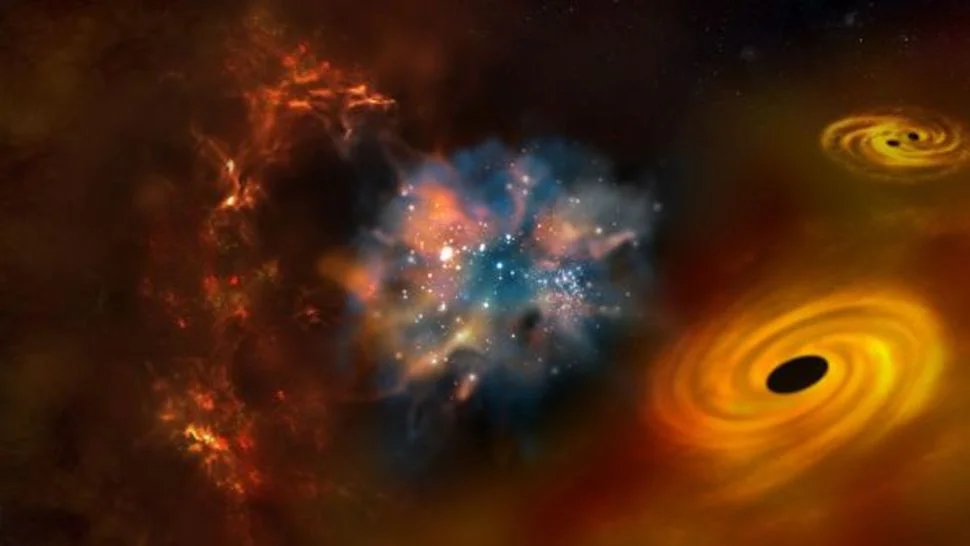Using the unprecedented capabilities of the NASA/ESA/CSA James Webb Space Telescope, an international team of scientists has obtained the first spectroscopic observations of the faintest galaxies during the universe’s first billion years. These findings were published in the journal Naturehelps answer astronomers’ old question: What sources caused the reionization of the universe? These new results effectively showed that small dwarf galaxies are likely producers of very large amounts of energetic radiation.
The study of the evolution of the early universe is an important aspect of modern astronomy. There is much to understand about the period in the early history of the universe known as the epoch of reionization.
It was a period of darkness with no stars or galaxies, filled with a dense hydrogen fog, until the first stars ionized the gas around them and light began to pass through. Astronomers have spent decades identifying sources that emit radiation strong enough to slowly dissipate this hydrogen fog that blanketed the early universe.
The Ultradeep NIRSpec and NIRCam Observations Before the Reionization Epoch (UNCOVER) program (#2561) contains images and spectroscopic observations of the Abell 2744 lens cluster. An international team of astronomers used gravitational lensing of this target, also known as the Pandora cluster. , To investigate the sources of the reionization period of the universe.
Gravitational lensing magnifies and distorts the appearance of distant galaxies, so they appear quite different from the foreground. The “lens” of the galaxy cluster is so large that it warps the fabric of space so much that light from distant galaxies passing through the distorted space also takes on a distorted appearance.
The magnification effect allowed the team to examine very distant light sources beyond Abell 2744, revealing eight extremely faint galaxies that even Webb would otherwise have been unable to detect.
The team found that these faint galaxies are huge producers of ionizing radiation, at levels four times higher than previously estimated. This means that most of the photons that reionize the universe probably come from these dwarf galaxies.
“This discovery reveals the important role that extremely faint galaxies played in the evolution of the early universe,” said team member Iryna Chemerynska from the Institut de Astrophysique de Paris in France. “They produce ionizing photons that transform neutral hydrogen into ionized plasma during cosmic reionization. This underscores the importance of understanding low-mass galaxies in shaping the history of the universe.”
Hakim Atek, team leader from France’s Sorbonne University, Paris Astrophysics Institute, and lead author of the article explaining the result, added, “Together, these space power plants emit plenty of energy to get the job done.” “Despite their small size, these low-mass galaxies are powerful producers of energetic radiation, and their excess during this period is so great that their collective impact could change the entire state of the universe.”
To reach this conclusion, the team first selected extremely faint candidate galaxies in the reionization epoch by combining data from the Webb Ultradeep Imager with the complementary image Abell 2744 from the NASA/ESA Hubble Space Telescope. This was followed by spectroscopy using Webb’s Near Infrared Spectrograph (NIRSpec). The instrument’s multiple shutter assembly was used to obtain multi-object spectroscopy of these faint galaxies.
Scientists have accurately measured the density of these faint galaxies for the first time and successfully confirmed that they are most abundantly populated during the reionization epoch. This also marks the first time the ionizing power of these galaxies has been measured, allowing astronomers to determine whether they produced enough energetic radiation to ionize the early universe.
“NIRSpec’s incredible sensitivity, combined with the gravitational enhancement provided by Abell 2744, allowed us to identify and study in detail these galaxies from the first billion years of the universe, despite being 100 times fainter than the Milky Way.” Atek continued.
In Webb’s upcoming GLIMPSE observing program, scientists will obtain the deepest observations of the sky. By targeting another galaxy cluster called Abell S1063, even fainter reionization period galaxies will be identified to test whether this population represents a large-scale galaxy distribution.
Since these new results are based on observations from a single region, the team notes that the ionizing properties of faint galaxies may manifest differently if they are in extremely dense regions. Therefore, additional observations in an independent field will provide more information to help test these findings.
GLIMPSE observations will also help astronomers explore the period known as the Cosmic Dawn, when the universe was only a few million years old, and advance our understanding of the formation of the first galaxies.













